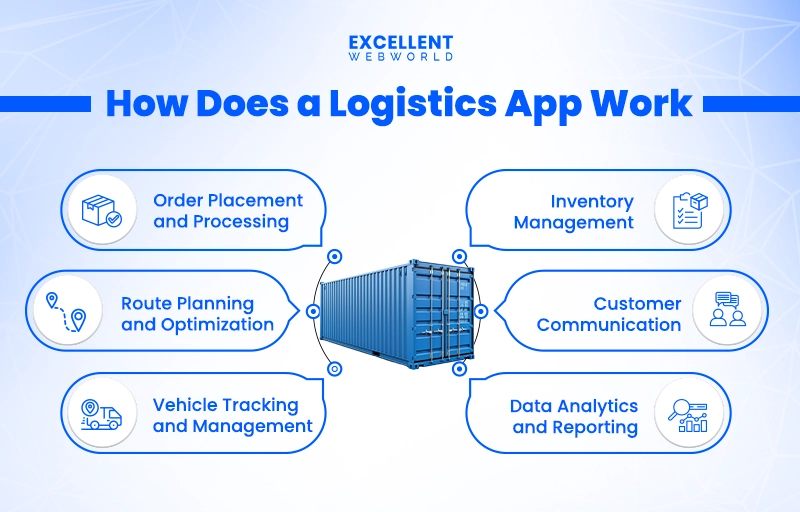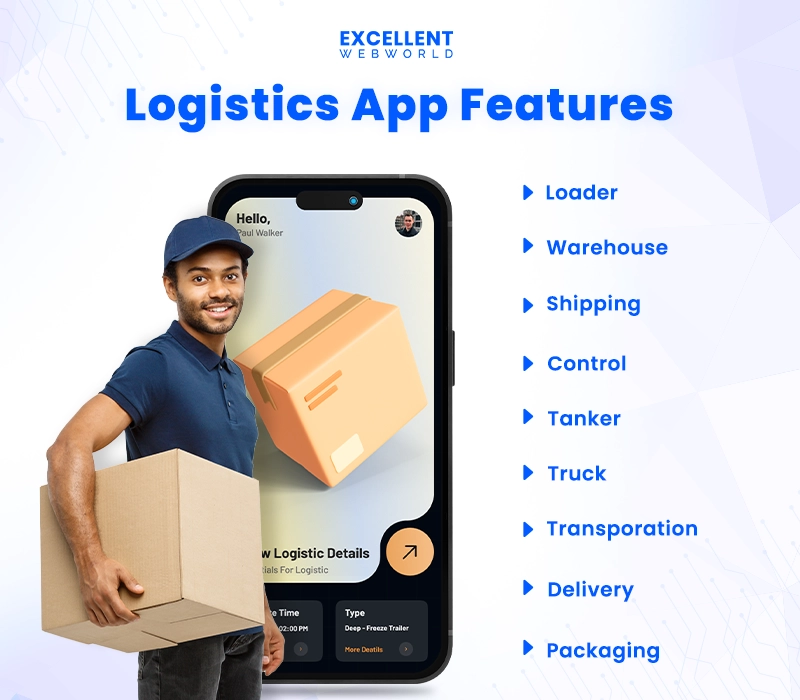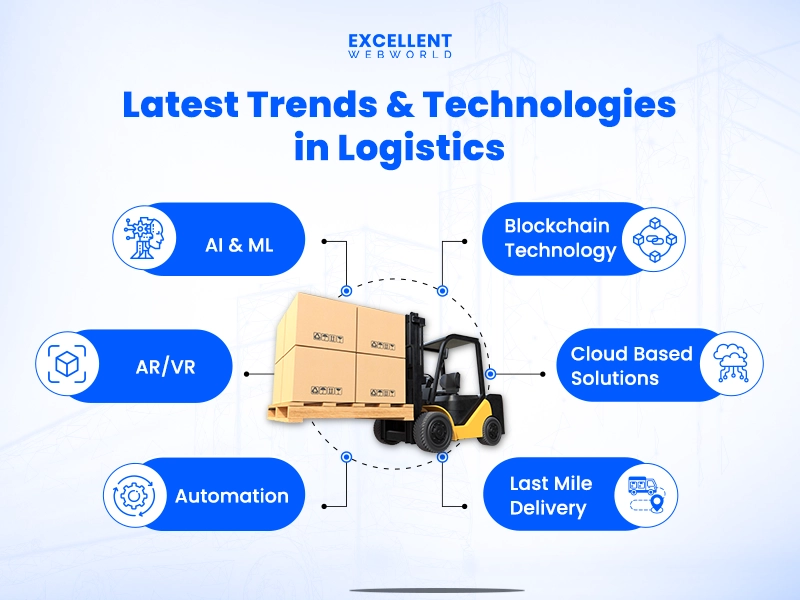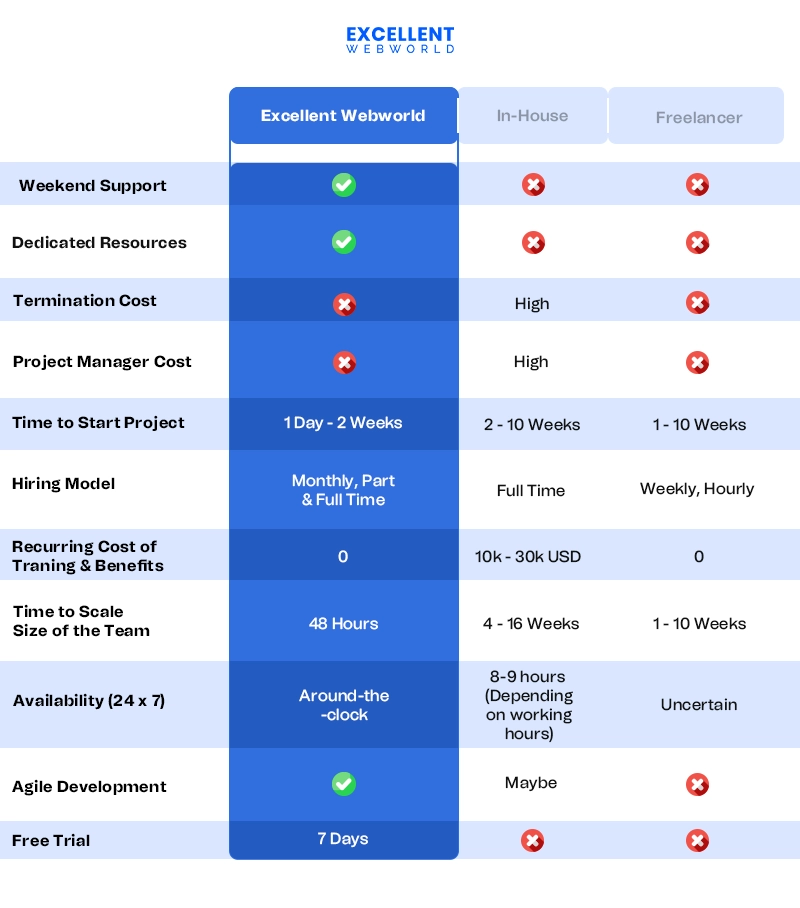Logistics and supply chain enterprises need to manage massive cargo fleets. This is, of course, an enormous challenge with multiple variables. For example, a truckload of cargo worth millions can get stuck in a snowstorm in Alaska. Without a system that offers real-time updates and access to the driver’s location, this can be a nightmare. This is where logistics app development comes into play.
But why build a logistics app for it?
Well, firstly, because it’s the most convenient option for entrepreneurs like yourself. A logistics app lets your business track each cargo and delivery in real-time. Plus, you can convey weather and roadblock data to drivers instantly. Adding dedicated apps for the drivers for your logistics operations can further amplify efficiency. This needs a strategic logistics app development approach where you build features as per operational needs.
Strategizing and implementing the app development plan may seem overwhelming, but don’t worry. Excellent Webworld is here to help! We have 12+ years of experience in successfully delivering logistics apps for our various clients based in the US, GCC, MENA, and Europe region. On the basis of our expertise, we have created a roadmap for logistics app development that includes feature identification, cost estimation, and much more.
But before you start getting your whiteboard ready, let’s first understand the basics!
What Is Logistics App Development?
Logistics app development involves creating software solutions to optimize the management of supply chain operations, enhancing delivery efficiency and tracking. These apps streamline processes from warehousing to transportation, ensuring real-time visibility and control. The app can have features for routing, vehicle maintenance, IoT fleet management, transportation, tracking, customer bookings, and more.
Startups and enterprises can create custom applications tailored to their business needs for efficient logistics operations. Logistics app development is relevant for several business domains besides logistics and transportation. Some of the common ones are listed here:
Benefits of Logistics App Development
A logistics app leverages advanced technologies to improve visibility, scalability, flexibility, compatibility, and more. There are several other benefits, some of which are mentioned here:
Here are several statistics that help firms better understand the rise in popularity of this type of app and the benefits of investing in logistics app development:
Functioning of a Logistics App
A logistics app plays a significant role in optimizing the overall logistics operations. Good logistics is a requirement for a wide range of industries. The detail of working on this type of app will help businesses gain a better understanding of it operates and how it will benefit them. It integrates several stages of a logistics operation and can either be a standalone system or seamlessly integrated with all the company operations.
An app like this can help optimize warehouse inventory management, making the driver’s task more straightforward and optimizing the supply chain process. It provides crucial and time-critical information to logistics managers to manage overall operations efficiently. It streamlines communication and provides real-time updates on the package, driver, and route, thus ensuring no blockage in any stage of the supply chain.
A system like this also uses automation to eliminate human error and increase efficiency. It also implements advanced technologies like AI and ML to improve efficiency and ensure customer satisfaction. In layman terms, a logistics app greatly optimizes every aspect of a logistics business. This includes shipment, movement of goods, fleet, and more. A digital command center allows an administrator to receive real-time status and control operations.
Logistics App Process Flow
1. Integration with Company Operations
2. Warehouse Inventory Management
3. Driver Assistance
4. Supply Chain Optimization
5. Technology Implementation
6. Real-Time Monitoring and Updates
7. Enhanced Decision Making
8. Customer Satisfaction
7 Different Types of Logistics Apps
There are several types of logistics apps one can develop. They can be customized as per the industry’s requirements and objectives. Here are the popular types of logistics apps to help you get a better understanding:
Last-mile delivery:
This type of app optimizes the final stage of the shipment. It helps manage deliveries from a distributor center or warehouse to the final destination. Last-mile delivery apps are used widely by eCommerce and retail businesses to implement this app to ensure customer satisfaction.
Transportation management:
It helps in optimizing various aspects of the transportation process. It typically involves special features to optimize the planning and execution of shipment activities. The app also uses advanced technologies like AI/ML to automate several elements to eliminate human error. Some of the modules of this type of app include shipping planning, exception management, and real-time tracking.
Warehouse inventory management:
Managing a warehouse without a robust software solution would be a nightmare, considering their sheer size. A logistics app can be custom-built to meet the unique needs of a warehouse, which typically means inventory and order management. It would involve using scanners and several other types of hardware.
On-demand logistics:
This is an app that directly connects customers or businesses. Hence, they can instantly request transportation services for their cargo from the mobile application. The shipment is assigned almost instantly and can be tracked in real-time. Examples include Uber Freight, DoorDash, and TruckZapp.
Driver management:
A driver management app is vital for optimizing schedules and routes in a logistics business. Features like real-time tracking, driver behavior monitoring, and dynamic route optimization are invaluable to any logistic operation.
Supply chain management:
Managing a logistics business’s supply chain system effectively requires streamlining the scheduling, route selection, and delivery time estimation processes. A custom logistics app can help achieve this.
All-in-one logistics:
The name says it all. A logistics business requires the smooth functioning of every leg of its business. An all-in-one logistics app helps optimize every aspect of the industry, such as fleet, warehouse, employment, and delivery management.
Process For Robust Logistics App Development
Developing a logistics app involves overcoming challenges and selecting the right tech stack, which is vital for choosing the right development team. Outsourcing logistics app development can significantly benefit businesses, especially startups.
Depending on the type of logistics app you decide to build, you might end up with a long list of features to include in the development process. However, due to time or money constraints, including all the features is often not feasible. Hence, the ideal approach is to develop a minimal viable product (MVP) with minimal functionality. This is highly cost-effective and ensures a faster time to market.
Here are a few tips for developing a full-fledged logistics app:
1. Market Research
The first step in developing a logistics app is verifying your business idea. Analyze industry trends, competitors, and target audiences to identify gaps and opportunities in the logistics domain for your app. Ensure that the app you wish to develop aligns with the user’s needs and demands.
Market Research Checklist
1. Industry Analysis
2. Competitor Analysis
3. Target Audience Identification
4. Opportunity Identification
5. Validation
2. Define Requirements
Identify the primary purpose of building the logistic app. This can increase delivery efficiency, improve real-time tracking, improve inventory management, or create an app with a good monetization strategy. Define the app’s purpose, user roles, and core functionalities to set development goals and streamline the process. In your requirements, prioritize scalability, performance, and security.
Define Requirements Checklist
1. Purpose Definition
2. User Roles and Permissions
3. Core Functionalities
4. Scalability
5. Performance
6. Security
3. Create Feature-list
Develop a list using the detailed lists mentioned in the previous section. This is to develop a list of essential features at a good time to decide to build a Minimum Viable Product (MVP) and gather user feedback before creating a full-fledged application.
Create Feature-list Checklist
1. Essential Features
2. Feedback Mechanisms
3. MVP Planning
4. UI/UX Design
A good design with an interactive interface is crucial for the success of any application, including a logistics app. Design an intuitive and responsive interface for easy navigation by customers, drivers, and administrators. Focus on seamless user experiences across devices. It is best to be more involved with the mobile app design company and provide them with a clear picture of our custom requirements.
UI/UX Design Checklist
1. Design Principles
2. Responsiveness
3. Interactive Elements
4. Visual Design
5. Prototyping
6. User Testing
7. Collaboration with Designers
5. App Development
Opt for agile methodologies and implement features iteratively while integrating APIs for GPS, payments, and analytics. Develop backend architecture to handle real-time data processing. It is best to outsource it to a professional mobile app development company that is an expert at developing such applications and has knowledge of advanced technologies.
App Development Checklist
1. Methodology
2. API Integration
3. Backend Architecture
4. Outsourcing
6. Quality Assurance
Testing will ensure the application is free from bugs and errors. Conduct extensive testing, including functional, performance, and security tests, to ensure the app operates smoothly and is bug-free before launch. Ideally, This would require a dedicated QA team with manual and automated testing skills.
Quality Assurance Checklist
1. Testing Strategy
2. Functional Testing
3. Performance Testing
4. Security Testing
5. Team Requirements
7. Deployment
This involves configuring the application to ensure it meets the platform’s requirements where it is to be deployed. The development team will handle this. It typically means launching the app on a cloud platform and app store, such as the iOS App Store or Android Play Store. It also involves configuring for scalability, monitoring tools, and user onboarding processes.
Deployment Checklist
1. Configuration
2. Cloud Deployment
3. App Store Deployment
4. Monitoring Tools
5. User Onboarding
8. Support and Maintenance
Provide regular updates, address user feedback, and ensure compatibility with new devices and technologies to keep the app functional and user-friendly over time.
Support and Maintenance Checklist
1. Updates
2. Feedback Integration
3. Compatibility Checks
4. Technology Updates
Integration With Other Systems
Developing a logistics app doesn’t usually end with creating an app with essential features and a good interface. More often than not, it includes integrating the app with existing legacy systems. This is essential to achieve the full potential of your logistics app. It usually means seamless integration with warehouse systems, shipping carriers, eCommerce platforms, ERP systems, payment gateways, etc.
The main aim of this is to reduce the effort to manage the entire system and improve efficiency. It also helps increase visibility, reduce cost, and improve customer experience. Integrating API and third-party services will result in providing a 360-degree view of the operations:
| APIs | Purpose |
|---|---|
| EasyPost API | Access to shipment changes, labels, tracking information, and more is available for USPS, UPS, and FedEx. |
| FexEx API | Access to shipping rates tracking information, labels, and more for FedEx |
| USPS API | Access to USPS shipping rates, labels, and more for USPS |
| Shippo API | Access to shipping rates, label information, and more for USPS, UPI, and FedEx. |
| Shipwire API | Allows to manage inventory, order details, and more for various service providers |
| Google Map API | Provides data to track routes, estimate traffic times, and more |
| LogiNext API | REST API to collect data on vehicles, drivers, transit points and more |
| Royal Mail Shipping API | Allows integration with Royal Mail in Great Britain for delivery services. |
This example will better explain the benefits: An order is placed on an eCommerce portal that automatically alerts the logistics concern to process it. The customer can use the app to track the package in real time. At the same time, the inventory is updated once the product is shipped from the warehouse. The technical aspect of this introduces the need for APIs, security levels, data mapping, and more.
Features for Logistics App Development
The features included in the logistics app will depend on its purpose. For example, the features of load planning software will differ from the features of a freight app.
Below are the features to consider for your logistics app development project based on the stakeholders it impacts:
Shipper App Features
Driver App Features
Admin Pannel Features
Customer App Features
Dispatcher App Features
Tech-Stack Selection
Choose scalable and reliable technologies for frontend, backend, and database development. Other popular categories include selecting appropriate technologies for cloud computing, APIs, real-time features, IoT, DevOps, security, and AI/ML.
The tech stacks for logistics app development looks like this:
| Development | Technologies |
|---|---|
| Frontend | Angular, React.js, Vue.js, Flutter |
| Backend | Node.js, Ruby on Rails, Python, Expres.js |
| Database | MongoDB, MySQl, PostgresQL |
| Cloud Hosting | AWS, Google Cloud, Microsoft Azure |
| APIs | Stripe, Razorpay, Paypal, Google Maps |
| DevOps | Docker, Kubernetes, Jenkins |
| Security & Testing | SSL, Selenium, OWASP ZAP, Nessus |
Main Challenges in Logistics App Development
Developing a logistics app is not free from challenges; in fact, it requires one to have extensive knowledge of the workings of this type of system. Common issues include dealing with GPS errors, complex routes, traffic, and weather. It takes highly skilled developers with knowledge of advanced technologies to develop a system that integrates with existing systems.
Here are some of the common challenges:
1. Integration With Existing Systems:
Considering the sheer size of the logistics operations, it will likely consist of several legacy systems. Integrating them with a new logistics app often poses a big challenge. A professional team of developers is necessary to accomplish this.
2. Real-Time Tracking & Monitoring:
In order to track shipments and drivers in real time, a system like this depends on various factors like GPS data accuracy, correct data transmission, and timely updates. Many things can go wrong with this, which in turn would affect the entire delivery schedule. However, an experienced team will get this right.
3. Route Optimization:
This feature dynamically provides the best route for the drivers to maintain the proper schedule. It is based on factors such as traffic and weather. Implementing a robust algorithm that accounts for various factors requires developers with high-level skills.
4. Security & Data Privacy:
Robust security is essential since this system has sensitive information on customers, packages, and the company. This often poses a big challenge.
5. Scalability:
The need to scale often arises with increased traffic, larger datasets, and complex operations across more time zones. This is only possible for an app designed well, considering future expansions.
6. Automation:
The amount of resources and data necessary to introduce automation is very high, and experts must write well-written algorithms. This is often a requirement to reduce human error in repetitive tasks in various sectors like inventory management and route optimization.
7. User Experience:
User experience is crucial for the success of an app like this. It is common to overlook this while focusing more on the complex functionality. The key to delivering an intuitive interface is keeping it simple and considering that it involves many types of users with a different skill level.
8. Customer Expectation:
Besides developing a feature-rich and intuitive app, it also needs to meet the user’s expectations regarding reliability, speed of operations, and demand consistency. This is a common concern that developers need to address early.
5 Logistics Application Development Trends To Transform Your Operations
Technologies like GPS, AI/ML, Blockchain, and IoT have already significantly impacted these types of apps. Several firms are already implementing them in many innovative ways to provide users with more functionality. All logistics apps must incorporate the latest trends and leverage the latest technologies to thrive in this highly competitive market. Here are a few trends:
1. AI & ML
AI/ML is increasingly used to improve operational efficiency, reduce costs, and enhance decision-making.
2. IoT Integration
Implementing IoT in logistics is highly efficient for enhancing visibility, managing inventory control, and proactive maintenance, making it the chosen technology for many firms.
3. Blockchain Technology
Blockchain technology is gaining popularity since it is highly efficient in improving trust, data security, and transaction efficiency.
4. Cloud Computing
More firms are adopting cloud solutions for cost-effective scalability, real-time data sharing, and enhanced collaboration.
5. Big Data and Advanced Analytics
This is gaining popularity with an increase in the volume of data generated daily and the need for real-time analysis. It optimizes data-driven decision-making and enhances forecasting accuracy.
Popular Use Cases For A Logistics App
Logistics apps have many applications since they serve several purposes for a logistics business. It helps streamline communication and several other aspects. Here are some of the popular user cases:
Common Factors Affecting The Cost Of Logistic App
A wide range of factors influences the logistics app development cost. Some of the main factors include:
How Much Does It Cost To Develop A Logistic App?
As mentioned in the section above, several factors affect the cost of logistics app development. However, here is a table to paint a more detailed picture:
| Type of App | App Cost |
|---|---|
| Simple | USD 20,000 – USD 55,000+ |
| Medium | USD 55,000 – USD 85,000+ |
| Complex | USD 90,000 – USD 210,000+ |
The overall cost depends greatly on the scope of the project. This is especially true for a logistics app because it can be developed for various purposes. For example, businesses can benefit from building a trucking dispatch software often called a fleet management tool.
Other applications include warehouse management, eCommerce logistics, freight management, inventory management, and supply chain management. The features and complexity are as crucial as the time it takes to develop. Hence, the cost of producing it also varies.
The popular option is to outsource the development of such an application. Hence, the logistics app development company you choose will also dictate the development cost. The price may vary depending on the type of professionals you require, like business analysts, solution architects, UI/UX designers, QA, and project managers.
Additionally, the country from where you hire the logistics app development company also plays a significant role, as mentioned in the table below:
| Location | Cost |
|---|---|
| USA | USD 150,000 – 250,000+ |
| India | USD 20,000 – 120,000 |
| Ukraine | USD 70,000 – 2,00,000+ |
| Mexico | USD 40,000 – 2,00,000+ |
The Future of Logistics App Development
Various industries have widely accepted the logistics apps, and there has been no looking back since their implementation. The long list of benefits and cost-savings far outweigh the initial investment to develop a logistics app. With advances in technologies like AI/ML and AR/VR making it simple to manage operations, the future of logistics apps is looking bright.
These statistics should provide some insight into the popularity of this app and what the future holds. The market size of the logistics industry worldwide was USD 9.4 Trillion at the start of 2024. It is expected to rise to USD 31 Trillion by 2032.
Hire Expert Developers From Excellent Webworld
Logistics apps are revolutionizing the supply chain industry by improving efficiency, reducing costs, and enhancing customer experiences. A custom logistics app will help your business overcome unexpected issues when you least expect them.
That is where Excellent Webworld comes in; we are a logistics app development company with expertise in developing a wide range of applications. We build custom logistics apps that are easy to scale and meet the rising demands. Our extensive list of services includes developing solutions for order management, warehouse management, and last-mile delivery.
We also provide other services, such as transport and logistics app development. Our highly skilled team of developers keeps up with the latest technologies to deliver highly competitive solutions that give your business the edge. Trust us with your requirements.
Get in touch with us for cost-effective logistics app development. The table below explains the benefits of outsourcing to Excellent Webword.
FAQs
A scalable logistics app is a software solution designed to manage and optimize logistics operations while allowing for seamless growth. It accommodates increasing user demand, data volume, and new features without compromising performance.
Migrating an existing app to a robust cloud platform can scale it. This will require refactoring the codebase, upgrading the database, and implementing several other technologies, such as AI.
The time required to develop a logistics app will depend on its complexity. It can take as little as three months or two years.

Article By
Mahil Jasani began his career as a developer and progressed to become the COO of Excellent Webworld. He uses his technical experience to tackle any challenge that arises in any department, be it development, management, operations, or finance.





